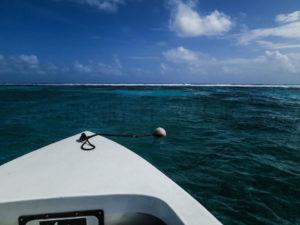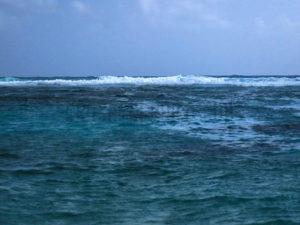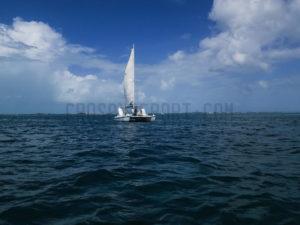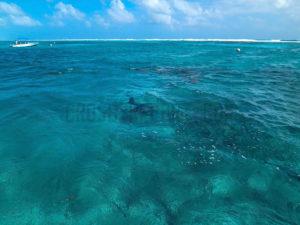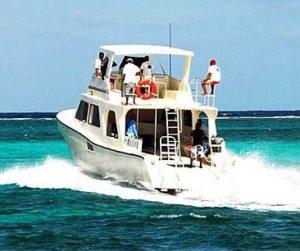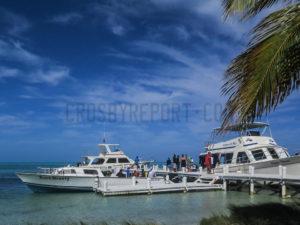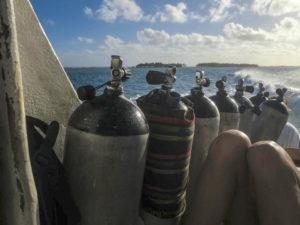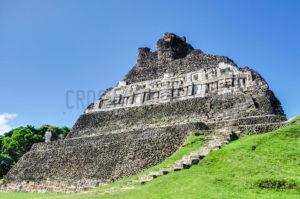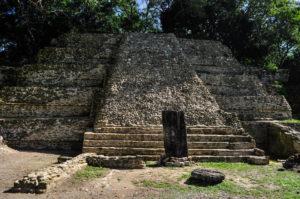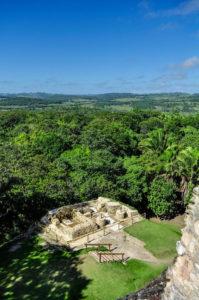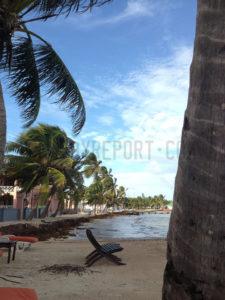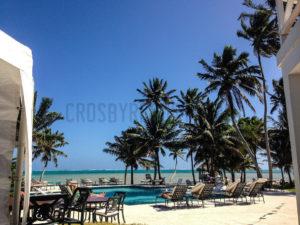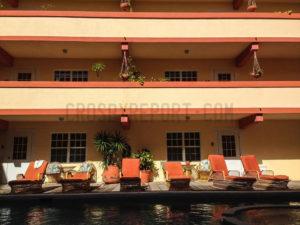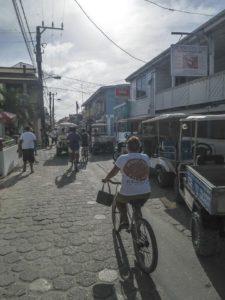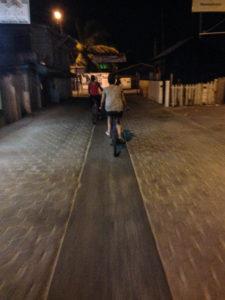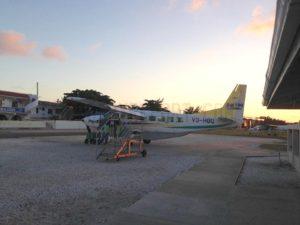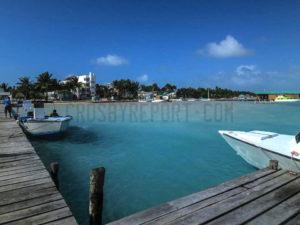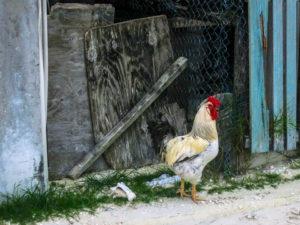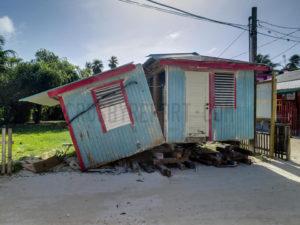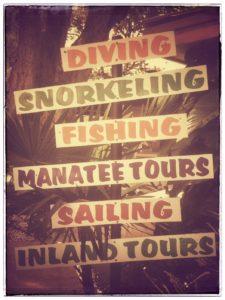People don't come to Belize to get lentigo malign on its beaches — frankly, they're not the white sandy kind you find around the Hawaiian, Caribbean, or Galápagos Islands. Instead, people come for what those islands don't have: an epic, ocean-taming barrier reef.
Wait, Belize has a barrier reef? What's that again?
In this case, it's a 200-mile-long stretch of underwater coral that keeps the crushing, wind-fueled Gulf Of Mexico waves about 1,000 feet away from Belizean beaches. The result is a coastline of gently lapping waves under which all manner of fish and plant life thrive.
The area of calm is so large, in fact, that Ambergris Caye is entirely located within it. Amazingly, it's still only the second largest barrier reef in the world, the Great Barrier Reef in Australia is the biggest.
You'll wish you liked snorkeling more.
Honestly, I'm not a big snorkeler or scuba diver. And the more I learn about the horrors of the undersea world, the less inclined I am to jump in half naked and paddle about like a wounded seal. That being said, the snorkeling in Belize was great. Initially, we stayed close to Ambergris Caye and went to Hol Chan and Shark Ray Alley, two areas that are part of the Belize national park system.
As part of the national park system, Mexico Rocks also has a park ranger that sits in his boat all day making sure tourists don't just stumble into the area and mess up the coral reefs (however, I imagine that “Reef Police” would make for a terrible cop show).
Hol Chan mostly had colorful smallish fish, brain coral, and the odd sea turtle, whereas Shark Ray Alley was mostly sharks, sting rays, and the occasional Eagle Ray which can fly right out of the water like…um, a bird of some kind.
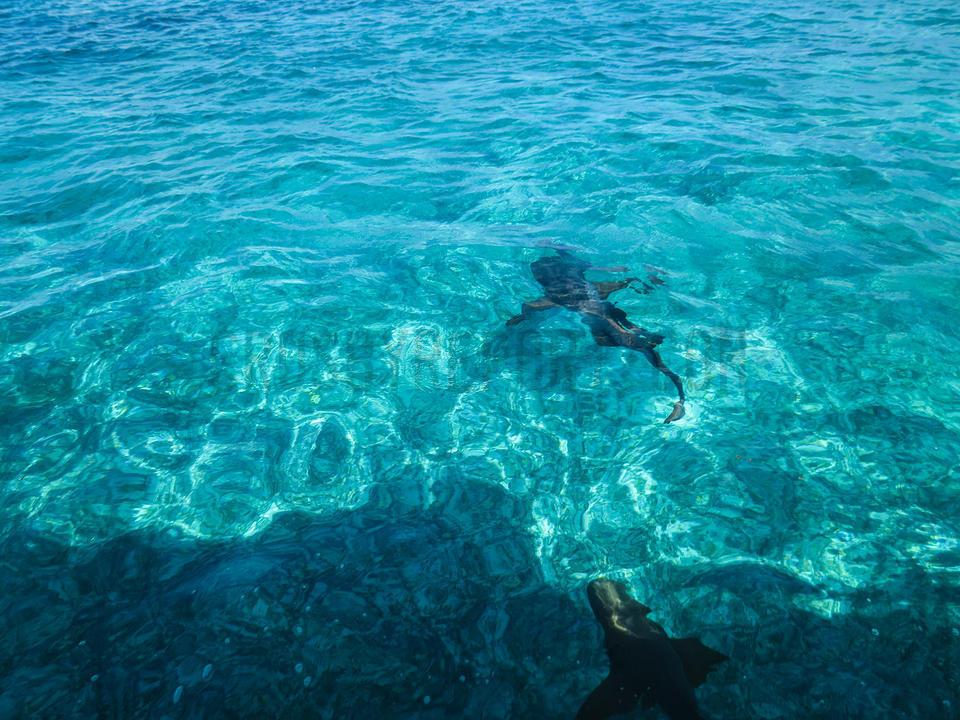
Sharks? Yes. With freaking laser beams? No.
Shark Ray Alley (which the locals weirdly pronounce as two words: “shark-reale”) is an area where disturbingly huge nurse sharks and blue southern sting rays wait around for tourist boats to bring them free food (herring, not unwitting tourists). And, though terrifying to see up close due to their dead soulless eyes, the nurse sharks and sting rays are mainly harmless bottom scavengers who aren't fast or motivated enough to catch prey on their own. So, as long as you stay alive and ambulatory, you're in no real danger of losing a limb or going home with any cool scars.
Mexico Rocks in Belize only sounds racist.
We had such a good time at Hol Chan and Shark Ray Alley that we then made plans to snorkel the Mexico Rocks area north of Ambergris Caye the next day. Like Hol Chan, the azure, warm water around Mexico Rocks contained the same colorful fish, weird brain coral, and sea turtles, so you could do one place or the other and not really miss much. But for really epic snorkeling, we assumed, you had to go to Belize's world-famous Great Blue Hole.
The Great Blue Hole is just that.
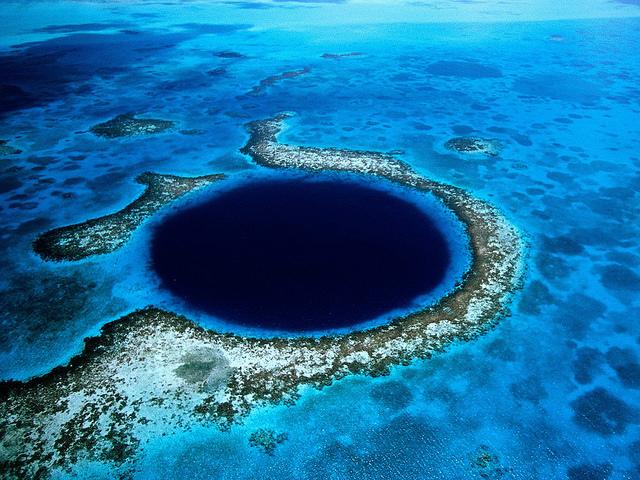
The Great Blue Hole, which only sounds like a gay bar, is actually just a huge sinkhole near Lighthouse Reef, about 45 miles from the mainland — more critically, it is located outside the barrier reef. Here's why that fact matters:
To get there, we boarded a 24-foot AquaScuba day-tour boat at 5:30 in the morning. The first ten minutes of the trip were calm and peaceful as we sailed out towards the barrier reef. But once we got there, the wind and waves hit us like a Category 5 hurricane and the water changed from jewel-tone teal to dark, boat-capsizing blue.
We spent the next 45 minutes desperately hanging onto the boat and, more importantly, our lunches — four passengers fed theirs to the fish within minutes of hitting the break. That stomach-churning introduction to the might of the sea finally dumped us into an atoll and everything calmed down, but it didn't last. After a 30 minute reprieve, we were back in open water and once again miserable.
Our guides said that the chop was “worse than normal, but not as bad as they'd seen” which made me wonder how bad it had to be before they'd cancel the trip.
Once we got to the Great Blue Hole (or GBH), things calmed down dramatically — the teal water was back and the waves were tame. We anchored at the edge of the GBH and disembarked into the tropical water. Our guide led us halfway around the Hole's 1,000-foot diameter pointing out basically the same fish, coral, and sea turtles that we saw at Hol Chan (with the exception of a cool moray eel). Turns out that the fascinating cave stuff is about 400 feet down. So, in retrospect, the GBH really isn't that exciting for us surface snorkelers.
Half Moon Caye isn't actually an island.
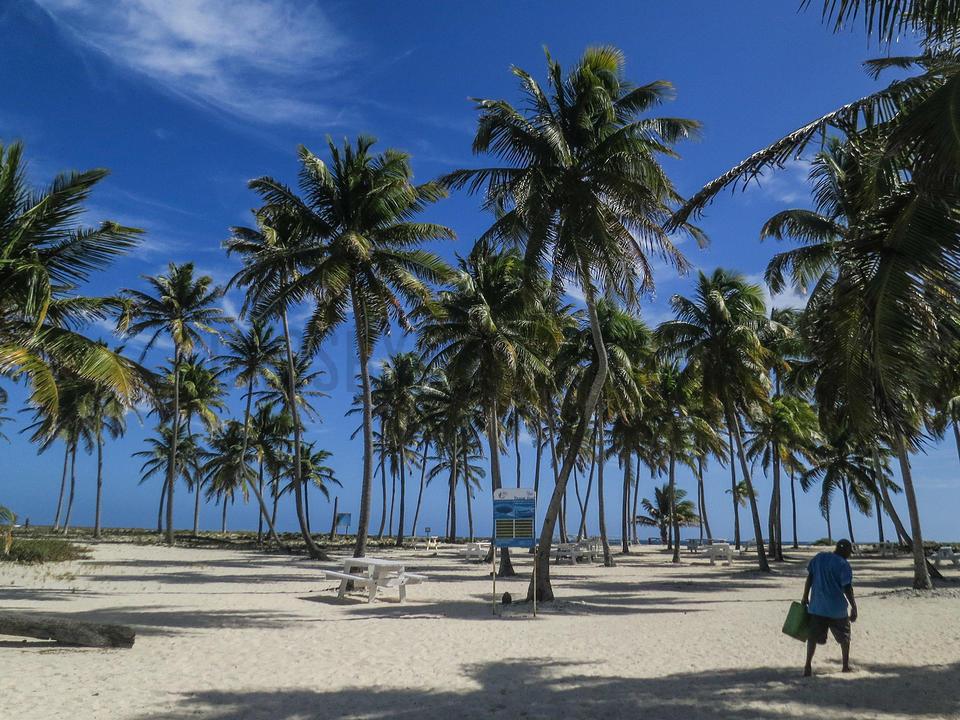
After snorkeling the rim of GBH, we sailed over to the nearby Half Moon Caye — okay, not to the actual caye itself. We got dumped about a quarter mile from shore and, to avoid being swept away to our deaths, had to swim to land.
What we first thought was a deserted tropical isle turned out to be somewhat more developed. Almost immediately after walking in off the beach, we came upon a bird sanctuary for huge frigate birds and red-footed boobies (not the stupid, suicidal blue-footed ones we saw in the Galápagos).
Continuing further, we came to the other side of the small caye and found not only a good-sized dock for boats like ours, but clean, modern bathrooms, and even a gift shop for tourists.
Despite these concessions to tourism and financial realities, Half Moon Caye was probably the most visually attractive place we'd seen in Belize — it had a decent beach (see photos) and palm trees grew like palm weeds.
Our full-day trip turned out to be a full day.
After a lunch of traditional Belizean cuisine — stewed chicken, rice, beans, and cole slaw — we reluctantly left Half Moon Caye and headed to Lighthouse Caye for even more snorkeling. Once there, our guide chummed the water with small dead fish and, in no time, the area was teeming with hungry, lazy large fish looking for a damn handout. (Get a job, you socialist yellow-tail snapper!) Still, it was amazing to see tropical fish up so close you could punch them.

After a long, full day of watching colorful fish evacuate their tiny bowels, we were all exhausted and not in the mood to wretch our rice and beans out on the trip back to Ambergris Caye.
Fortunately, this time we were sailing with one of the elemental forces of Nature — i.e., wind — instead of against it, so the trip couldn't have been more calm or relaxing (which was good because we really liked that Belizean food). The difference between the two trips was stark — whereas sailing out tested your faith in a loving god, sailing back tested your tolerance for stultifying boredom.
In hindsight, I wouldn't recommend visiting the GBH if you're a snorkeler. The heave factor of the trip out just isn't worth all the corn chunks. Most importantly, you won't really see anything that you can't see on a half-day outing closer to Ambergris Caye. If you do make the trip, take a half-bottle of Dramamine first. (Consult your doctor).
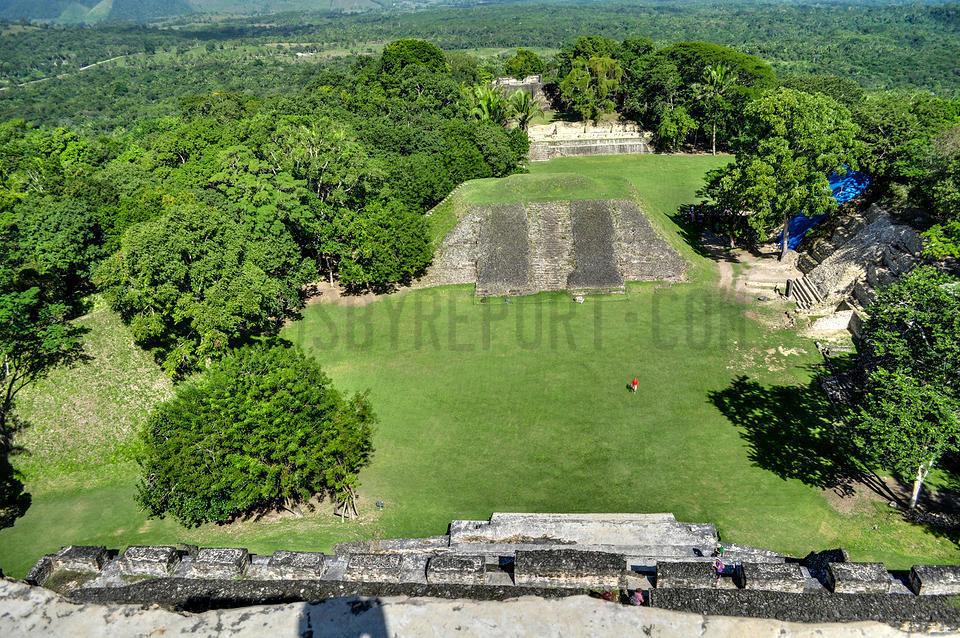
But what if you don't like getting wet?
For land-lubbers, Belize offers a variety of soil-based sightseeing including Xunantunich, a site of Mayan ruins on the border of Guatemala about 80 miles from Belize City. Much like Mexico's more famous Chichen Itza, Xunantunich has a stone pyramid and a crazy Mayan name. In addition, both places have religious temples where all manner of head-chopping and deviant sexual acts probably happened for a few hundred years. So that's cool.
The ruins in Belize aren't as impressive as the ones in Chichen Itza, but the Belizean authorities will — for some insane reason — let you climb all over the Xunantunich ruins. You can even climb to the top of El Castillo (or “The Castle”) where you can see the border of Guatemala as well as the hospital they'll take your mangled body to when you fall 130 feet to the ground. One tourist had a GoPro® and we begged him to turn it on in case he fell — he didn't think that was funny.
Cave-tubing sounds more extreme than it is.
On our way back from the ruins, our guide pulled off the main road to do something called “cave-tubing.” This odd Belizean activity started auspiciously enough by making us wade across a slow-moving, waist-deep river.
Once on the opposite side, we hiked up a slight hill alongside the river for 30 minutes while carrying a large, inflatable donut-style tube. At the head of the river, we “put in” and immediately got our asses soaking wet (but just our asses, because we were sitting in inner-tubes).
Sitting in our inner-tubes, roped together like a group of prisoners, we floated down the river into a long, dark cave. We drifted silently into the eerie blackness with only our miner's helmet light to see that none of the cave's sleeping bats woke up and pooped in our mouths. Eventually, we returned to daylight and floated the rest of the way back to where we'd originally started to find a family of Mennonites chilling out (see sidebar).
Belize has only been “Belize” since 1973.
For about 2400 years, up until around 900AD, the area now known as Belize was actually three Mayan provinces. Unfortunately, the Mayans were technologically and militarily unprepared for the arrival of the Spaniards in the 16th Century, and so they met much the same fate as the Incas. After about 350 years of Spanish oppression and slavery, the British moved in and claimed the right to “administer” the country, renaming it British Honduras and declaring it a colony for 120 years or so.
As a result of the British overstaying their welcome a bit, the “native” language is now officially English (see also, imperialism). Not surprisingly, Belize's most recent foreign occupation makes the place particularly appealing to Americans from large or square states who can't speak Spanish (and barely English). Sadly, I have more respect for Americans who vacation in — and utterly ruin — Cancun, Mexico every winter than lazy people who won't even learn to say “Una cerveza, por favor.”
This is the place to drink and drive.
At some point during your vacation in Belize, all the sun and fun will work up a powerful thirst, compelling you to ask a waiter for margaritas, beer, tequila shots, or all three. But consider doing the locals a favor by not drinking Belikan beer. Why? Because the so-called “Beer of Belize” pretty much had a monopoly on the market for years and got to charge Belizeans whatever they wanted.
So support healthy competition and buy Presidente from the Dominican Republic and drink that beer proudly — hell, even while you're driving because, honestly, I don't even think drinking and driving is illegal in Belize (though you might want to double-check).
Where to stay in Belize.
We stayed at the mostly tolerable Banana Beach Resort due to an amazing package deal through Travelocity, but if you want to stay at a truly first-class resort, we'd recommend booking a room at Victoria House, located about a mile south of San Pedro.
We stopped in to eat lunch there and really liked everything about the place (except how the British Colonial architecture made us feel like scumbag Imperialist pigs). For less oppressive-feeling accommodations, there are a number of expensive hotels north of San Pedro, including an affordable yoga place called Ak'bol or something.
The best way to get around in Belize isn't by car.

Since our hotel was a mile or so south of San Pedro city in Ambergris Caye, we rented bikes for the week (US$100 for two). If we'd had to walk to every meal, we would've just kept eating at our hotel restaurant, El Divino Caribbean Steakhouse & Martini Bar. Most tourists rent a golf cart for the week, but that's only because most tourists are lazy, fat bastards. The irony is that two-stroke, polluting golf carts aren't any faster than bikes.
That's because the roads here are, quite honestly, shit. They're either punishing cobblestone, cracked concrete, or entirely non-existent. Some roads are one-way and some aren't, but you'll never guess which because there aren't any obvious road signs (okay, there are a few stop signs).
Worse, they have massive speed bumps of all kinds every 100 yards — in some places, they just lay two-inch thick rope across the road! Yeah, freaking rope! Essentially, if you're riding something with wheels, you won't be happy about it.
However, it is precisely these driving difficulties that make driving in Belize possible at all. If the roads were better, tourists would be able to drive their smoke-spewing golf carts fast enough to actually hurt someone.
As it is, the carts can't go much faster than about 15mph, and even then, not for very long. Every quarter mile or so, there's a HUGE speed bump that doubles as a pedestrian crosswalk — if you hit one at anything faster than 10mph, you'll get catapulted into the gulf.
Outside the glamour and bright lights of Ambergris Caye.
For most of our time in Belize, we stayed on Ambergris Caye. However, there are a number of cool “off-island” things to do — that is, sightseeing, snorkeling, or other outdoor activities that are located either back on the mainland, or on another island altogether. And to get there, you have only two modes of island-hopping transportation: Boats and airplanes.
Why 5,000 Mennonites live in Belize.
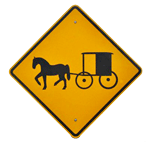
Weirdly, Belize has a large Mennonite population. That's because, in 1957 after this one-time colony of Britain won their independence, they needed to feed their population of 100,000. The government reached out to Mennonites in Mexico, who had lots of experience with large-scale farming. They negotiated a deal for land in exchange for the necessary large scale agriculture. And in the years following, some 1,700 Mennonites moved down. These now-Belizean Mennonites currently produce over 85% of the country's poultry and dairy products.
Boats are cheaper, but slower and more physically painful than you can imagine unless you were a tenderized piece of meat in a previous life. Despite the relatively calm water inside the barrier reef, the boats they use to shuttle people around still manage to somehow hit. Every. Single. Wave. If you're not sitting in the far back of the boat, your ass will come to regret it.
Flying is the best way to get anywhere fast in Belize.
Airplanes, on the other hand, are faster and every bit as comfortable as your average family SUV — problem is, they're also not much bigger. We literally sat right behind the pilot like he was an UberX driver (he wasn't). He was, however, the most blasé pilot I had ever sat directly behind.
Our pilot had the relaxed, almost bored demeanor of a man who'd made this 20-minute flight so many times he could do it blindfolded (thankfully, he didn't). So if you have to choose between sailing and flying, I recommend the latter.
What and where to eat in Belize.
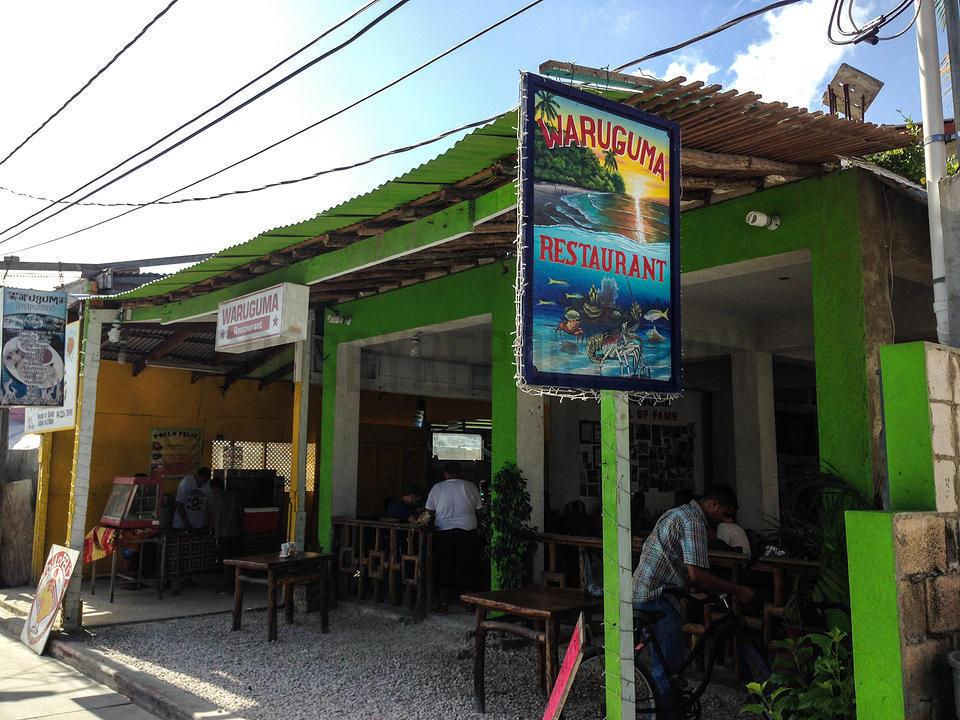
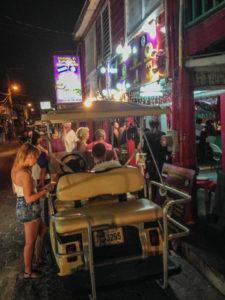
Unlike Balinese cuisine, Belizean cuisine is really very good. While most US restaurants serve pre-made, pre-prepped, and/or preprocessed foods, Belizean restaurants just serve real food fresh from gardens or the gulf so everything tastes farm-to-table fabulous.
The downside of that crazy approach to cooking is that getting your food takes foooorrrreeeeever (so bring your smartphone to every meal). We'd recommend eating dinner at Blue Water Grill or El Fagon (reservations at both are helpful). If you get too drunk to make reservations, El Divino is a solid second or third choice.

For lunch, the weirdly named Waruguma had good food, as did the upscale yet casual Elvi's Kitchen despite its floor made entirely of sand. If you're south of San Pedro and looking for a place with a beach view, try Amber Beach Bar & Grill which was pretty solid.
Robin's Kitchen in Ambergris is a roadside shack with amazing food but unreliable operating hours. For fancy coffee or cocktails in a seemingly abandoned but only partially built upscale resort, you can't do better than Rum + Bean. The downtown restaurant, Fido's Courtyard (pronounced “Feed-Doughs”) sucked and should be avoided.
FUN FACT: Belize is the lobster supplier for Red Lobster and the shrimp supplier for Long John Silver.
Hate modern conveniences? Then you'll love Caye Caulker!
If you think Ambergris Caye is “rustic,” you need to spend some time on the even smaller and far less developed Caye Culker.
This tiny caye is just south of Ambergris and straight out of Gilligan's Island — the entire place is powered by a single diesel generator (and not a gorilla riding an exercise bike made from coconuts, disappointingly).
The caye has three parallel roads: One has a bunch of tiny restaurants and tiny hotels along what passes for the beach, the second seems to be where the locals live, and the third is where the locals eat.
We had an amazing (but slow) meal at Maggie's Sunset Grill on Linds Cocal Street. If you want to write a novel where no one will bother you, Caye Caulker is the place.
Belize itself is no futuristic metropolis.
The natural beauty in Belize is indisputably impressive, what's not impressive is most everything else. This isn't Cabo San Lucas with tons of foreign investment and manicured designer golf courses. No, this is a relatively poor country of 350,000 people (16,000 on Ambergris Caye) for whom tourism and agriculture are its biggest sources of income.
Belize simply doesn't seem to have the tax revenues to pay for First World luxuries like smooth roads, reliable electricity, and non-shitty wifi. But the place still somehow works, albeit unexpectedly.
Belize is what it is and, luckily, its Caribbean climate and happy people cover its multitude of infrastructural sins. I couldn't see myself moving here to live the rest of my life as an Ex-pat, but I certainly understand why a lot of folks never want to leave.

